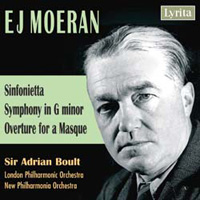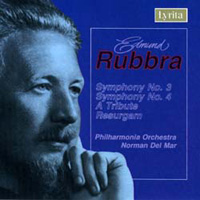 |
| October 1, 2007 Lyrita Redux
Richard Itter was as energetic as he was determined, and apparently never gave any thought to simply filling gaps: from the very beginning, Lyrita recordings showed as much care for sound quality as for authoritative performances. What would have been the point, after all, in unearthing the works of William Hurlstone or introducing us to the music of Alun Hoddinott if the performances were lackluster or given less-than-first-rate sound? Such names as those of Sir Adrian Boult and Vernon Handley were prominent among those of the conductors who recorded symphonic material with the big London orchestras; the singers and instrumentalists were on a comparable level, and so were the producers and engineers. At some point Lyrita also began taking on some material that had been issued earlier on such labels as Argo and Decca. Lyrita, despite its excellence, was not a conspicuous label in North America during the LP era. HNH, a short-lived but very savvy independent distributor, imported some Lyrita LPs and issued others on its own label. Still others enjoyed somewhat wider circulation on the label of the mail-order Musical Heritage Society. With the shift from LP to CD, Lyrita simply disappeared, and many of its LPs became sought-after collectors’ items. The label did not manifest itself in the new format until 1991, when quite a few Lyrita CDs began circulating, in masterings by Nimbus. But those were limited in number to 37 discs and, almost before there was time for their availability to register with the public, the label disappeared again. It was only this year that Wyastone Estate Ltd., having revived the Nimbus catalog and taken on Saydisc, began its project to recirculate the entire Lyrita catalog and augment the reissues with material that had not been issued earlier on either LP or CD.
More Moeran is available on SRC.248: the Rhapsody No.2, again with Boult and the LPO; the Violin Concerto (John Georgiadis, soloist, with the LSO under Vernon Handley), and the Rhapsody for piano and orchestra (John McCabe with the New Philharmonia under Nicholas Braithwaite). Among other recordings with Boult, I would mention a collection of brief works by George Butterworth, Herbert Howells, Peter Warlock and Patrick Hadley, alternating between the LPO and the New Philharmonia [SRCD.245]; Edmund Rubbra’s Seventh Symphony, with the LPO [SRCD.235 with the Second Symphony and Festival Overture performed by the New Philharmonia under Handley], and an Eric Coates program that includes the marvelous march The Dam Busters [SRCD.246]; and, in perhaps this labels’ nearest approach to the "standard repertory," the two Elgar Symphonies, with the LPO [SRCD.221, two CDs priced as one]. Boult made both earlier and later recordings of these symphonies, and all of them are splendid, but these are the ones to go for, surpassing all the rest in their incredible vitality, irresistible momentum and sheer brilliance of execution. One of Nicholas Maw’s early works, and one of the first to bring him international attention, was his Scenes and Arias, composed in 1962 as he was turning 27. The celebrated Argo recording with the soprano Jane Manning, the mezzo Anne Howells, the contralto Norma Proctor, and the BBC SO under Norman Del Mar, is coupled with two stimulating works by Anthony Milner on SRCD.267.
Possibly the earliest composer represented in the Lyrita catalog is William Sterndale Bennett (1816-1875), a composer much admired in his day, most notably by Robert Schumann, who dedicated his Symphonic Etudes to him. Bennett’s attractive Symphony in G minor and four of his descriptive overtures are conducted by Nicholas Braithwaite on SRCD.206. There is also one CD that is not devoted to British music -- but is made up entirely of transcriptions by the famous conductor Sir Henry Wood. This intriguing and rewarding program begins with Wood’s transcription of Bach’s Toccata and Fugue in D minor (originally credited to the fictitious "Paul Klenovsky" in order to avoid the critics’ dismissal as another mere conductor’s arrangement) and ends with his setting of Mussorgsky’s Pictures at an Exhibition, made as early as 1915 and withdrawn after Ravel’s celebrated version appeared seven years later. Between these mighty endposts are Wood’s no less intriguing versions of piano pieces by Chopin, Debussy, Scharwenka, Rachmaninoff, Grieg and Granados. Nicholas Braithwaite conducts the LPO in these early 1990s recordings [SRCD.216]. But there is hardly anything on this label that is not of solid interest. A numerical catalog, regularly updated, is available at www.lyrita.co.uk. All the CDs come with the original annotations, which are in all instances comprehensive and informative, and the sound quality, as already noted, is more than merely good. Adrian Farmer, the director of Wyastone Estate Ltd., has kindly supplied this clarifying and reassuring statement on that aspect of the current reissues: "In respect to the 37 Lyrita titles issued in the 1990s (and therefore prior to the Wyastone agreement), no new mastering has been undertaken. The digital source for Wyastone’s ongoing production of these titles was the issued CDs themselves. . . "Nimbus switched to CDR ‘on-demand’ manufacturing some four years ago. CDs [labeled] ‘Mastered by Nimbus’ are traditionally manufactured CDs that date from the 1990s; we took over a small stock of some titles in this format last year. SRCD.231, for instance, is exactly the same master as before, the only difference being that it is now manufactured using a CDR process rather than an injection-molding one. Since we are extremely careful to verify the data transfer in the duplication process from ‘original CD’ to ‘hard disc’ to ‘CDR,’ I consider it highly unlikely that this would introduce any audible variation . . . "Many of the titles released by Lyrita since January 2007 had been remastered to digital tape at 20 bits in the 1990s. In these cases we used the original tapes as the manufacturing source. Now, as we move deeper into the unreleased catalog, we retrieve the original analog tapes from storage and make transfers at 24 bits. Although both 20- and 24-bit transfers give us some ‘future-proof’ masters, sadly both types have to be reduced to 16 bits for issue on CD. "All the remastering, whether dating from the 1990s or being done today, [has been and continues to be] in the hands of Simon Gibson, a senior mastering engineer at Abbey Road." Ultra Audio readers familiar with Simon Gibson’s work will need no further recommendation. ...Richard Freed
Ultra Audio is part of the SoundStage! Network. |
 In the US, the UK and several other
countries there are record labels devoted largely or entirely to the music of the
respective countries’ own composers. Some of these have had the benefit of wider
distribution, and hence wider recognition, than others, and some have simply exhibited
greater staying power. One of the more remarkable examples was, and is, the British label
Lyrita, which was created by Richard Itter in 1959, issued its first LPs a few years later
and proceeded to build up a very substantial catalog of recordings of British music that
was for the most part less than familiar, even in Britain itself. Most of the works were
contemporary, or at least fairly recent, though some went back to the 19th century. Most
of the composers represented were well outside the international mainstream, such as
Arnold Bax and E.J. Moeran (who were far less well represented in recordings then than
now), but there were also unfamiliar works by the likes of Vaughan Williams, Britten and
Holst -- and occasionally there was an excursion closer to the standard repertory when it
was justified by an outstanding performance. By far the greatest portion of the works
included are orchestral, though there are several from the realm of chamber music.
In the US, the UK and several other
countries there are record labels devoted largely or entirely to the music of the
respective countries’ own composers. Some of these have had the benefit of wider
distribution, and hence wider recognition, than others, and some have simply exhibited
greater staying power. One of the more remarkable examples was, and is, the British label
Lyrita, which was created by Richard Itter in 1959, issued its first LPs a few years later
and proceeded to build up a very substantial catalog of recordings of British music that
was for the most part less than familiar, even in Britain itself. Most of the works were
contemporary, or at least fairly recent, though some went back to the 19th century. Most
of the composers represented were well outside the international mainstream, such as
Arnold Bax and E.J. Moeran (who were far less well represented in recordings then than
now), but there were also unfamiliar works by the likes of Vaughan Williams, Britten and
Holst -- and occasionally there was an excursion closer to the standard repertory when it
was justified by an outstanding performance. By far the greatest portion of the works
included are orchestral, though there are several from the realm of chamber music. This is an ambitious project, and it
is being pursued with the same level of enthusiasm as Richard Itter’s original
efforts. But, with the label’s recent history in mind, collectors are urged not to
allow this opportunity to go unnoticed. About a hundred items have been issued in the
current series. Among the gems, my own attention was drawn first of all to the stunning
Moeran package conducted by Sir Adrian Boult [SRCD.247]. Moeran’s Symphony in G minor
has always struck me as one of the most inexplicably neglected out-and-out masterworks of
20th-century symphonic music. British to the core, in spite of certain
"derivative" strains, it is also clearly music of its time (1937) and yet
genuinely timeless in its breadth, vitality and all-round urgency. The performance is one
of Boult’s greatest, and that, as Aunt Em used to say, is goin’ some. Framing
this terrific presentation of the Symphony with the New Philharmonia Orchestra are
Boult’s similarly persuasive accounts of the Sinfonietta and the Overture for a
Masque, both composed in 1944 and both played here by the LPO.
This is an ambitious project, and it
is being pursued with the same level of enthusiasm as Richard Itter’s original
efforts. But, with the label’s recent history in mind, collectors are urged not to
allow this opportunity to go unnoticed. About a hundred items have been issued in the
current series. Among the gems, my own attention was drawn first of all to the stunning
Moeran package conducted by Sir Adrian Boult [SRCD.247]. Moeran’s Symphony in G minor
has always struck me as one of the most inexplicably neglected out-and-out masterworks of
20th-century symphonic music. British to the core, in spite of certain
"derivative" strains, it is also clearly music of its time (1937) and yet
genuinely timeless in its breadth, vitality and all-round urgency. The performance is one
of Boult’s greatest, and that, as Aunt Em used to say, is goin’ some. Framing
this terrific presentation of the Symphony with the New Philharmonia Orchestra are
Boult’s similarly persuasive accounts of the Sinfonietta and the Overture for a
Masque, both composed in 1944 and both played here by the LPO. Two more Rubbra symphonies -- Nos.3
and 4 -- and the same composer’s Overture Resurgam and A Tribute, all
with the Philharmonia under Norman Del Mar, are on SRCD.202. Four stimulating works by
Elizabeth Maconchy, among them the Overture Proud Thames, conducted by Handley, are
on SRCD.288. No fewer than six works by Sir Arthur Bliss, with the composer himself among
the conductors, may be heard on SRCD.225.
Two more Rubbra symphonies -- Nos.3
and 4 -- and the same composer’s Overture Resurgam and A Tribute, all
with the Philharmonia under Norman Del Mar, are on SRCD.202. Four stimulating works by
Elizabeth Maconchy, among them the Overture Proud Thames, conducted by Handley, are
on SRCD.288. No fewer than six works by Sir Arthur Bliss, with the composer himself among
the conductors, may be heard on SRCD.225.